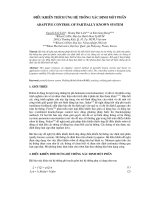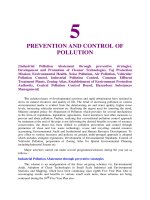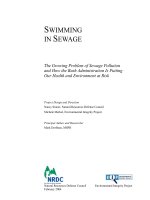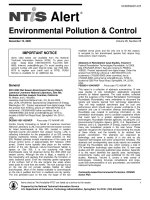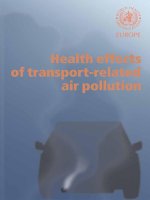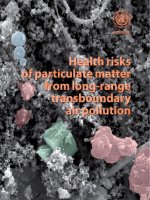CONTROL OF ENVIRONMENTAL POLLUTION ppt
Bạn đang xem bản rút gọn của tài liệu. Xem và tải ngay bản đầy đủ của tài liệu tại đây (333.03 KB, 7 trang )
CONTROL OF ENVIRONMENTAL POLLUTION
1. Preventive and Remedial measures for Air Pollution
• Keeping the environment clean and managing the wastes with the Guide lines of respective
Government
• The Exhausts from the Automobiles and workshop machinery should be controlled.
• The ISO standards must be followed strictly for Industrial usage.
What you can do to reduce air pollution?
• Encourage your family to walk to the neighbourhood market.
• Whenever possible take your bicycle.
• Don’t let your father drop you to school, take the school bus.
• Encourage your family to form a car pool to office and back.
• Reduce the use of aerosols in the household.
• Look after the trees in your neighbourhood.
• Begin a tree-watch group to ensure that they are well tended and cared for.
• Switch-off all the lights and fans when not required.
• If possible share your room with others when the air conditioner, cooler or fan is on.
• Do not burn leaves in your garden, put them in a compost pit.
• Make sure that the pollution check for your family car is done at regular intervals
• Cars should, as far as possible, be fitted with catalytic converters.
• Use only unleaded petrol.
2.Control of Water Pollution
Domestic sewage
In urban areas, domestic sewage is typically treated by centralized plants. In the U.S., most of
these plants are operated by local government agencies. Municipal treatment plants are designed to
control BOD and suspended solids. Well-designed and operated systems (i.e., secondary treatment or
better) can remove 90 percent or more of these pollutants. Some plants have additional sub-systems to
treat nutrients and pathogens. Most municipal plants are not designed to treat toxic pollutants found in
industrial waste water.
Cities with sanitary sewer overflows or combined sewer overflows employ one or more
approaches to reduce discharges of untreated sewage, including:
• utilizing a approach to improve storm water management capacity throughout the system
• repair and replacement of leaking and malfunctioning equipment
• increasing overall capacity of the sewage collection system (often a very expensive option).
A household or business not served by a municipal treatment plant may have an individual,
which treats the waste water on site and discharges into the soil. Alternatively, domestic waste water
may be sent to a nearby privately-owned treatment system (e.g. in a rural community).
Industrial waste water
Some industrial facilities generate ordinary domestic sewage that can be treated by municipal
facilities. Industries that generate waste water with high concentrations of conventional pollutants (e.g.
oil and grease), toxic pollutants (e.g. heavy metals, volatile organic compounds) or other non
conventional pollutants such as ammonia, need specialized treatment systems. Some of these facilities
can install a pre-treatment system to remove the toxic components, and then send the partially-treated
waste water to the municipal system. Industries generating large volumes of waste water typically
operate their own complete on-site treatment systems.
Agricultural waste water
Non-point source controls washed off fields is the largest source of agricultural pollution in
the United States. Farmers may utilize to reduce runoff flows and retain soil on their fields. Common
techniques include contour plowing, crop mulching, crop rotation, planting perennial crops and
installing riparian buffers.
Nutrients nitrogen and phosphorus are typically applied to farmland as commercial fertilizer;
animal manure; or spraying of municipal or industrial waste water (effluent) or sludge. Nutrients may
also enter runoff from crop residues, irrigation water, wildlife, and atmospheric deposition. Farmers can
develop and implement nutrient management plans to reduce excess application of nutrients.
To minimize pesticide impacts, farmers may use Integrated Pest Management] (IPM) techniques
to maintain control over pests, reduce reliance on chemical pesticides, and protect water quality.
Point source wastewater treatment-Farms with large livestock and poultry operations, such as
factory farms, are called concentrated animal feeding operations or confined animal feeding
operations in the U.S. and are being subject to increasing government regulation. Animal slurries are
usually treated by containment in lagoons before disposal by spray or trickle application to grassland.
Constructed wetlands are sometimes used to facilitate treatment of animal wastes, as are anaerobic
lagoons. Some animal slurries are treated by mixing with straw and composted at high temperature to
produce a bacteriologically sterile and friable manure for soil improvement.
Construction site Storm water
Discharge of toxic chemicals such as motor fuels and concrete washout is prevented by use of:
• spill prevention and control plans, and
• specially-designed containers (e.g. for concrete washout) and structures such as overflow
controls and diversion berms.
Urban runoff (storm water)
Effective control of urban runoff involves reducing the velocity and flow of storm water, as well
as reducing pollutant discharges. Local governments use a variety of storm water management
techniques to reduce the effects of urban runoff. These techniques, called (BMPs) in the U.S., may
focus on water quantity control, while others focus on improving water quality, and some perform both
functions.
Pollution prevention practices include low impact development techniques, installation of green
roofs and improved chemical handling (e.g. management of motor fuels & oil, fertilizers and
pesticides). Runoff mitigation systems include basin infiltration basins, bio retention systems,
constructed wetlands, retention basins and similar devices.
Thermal pollution from runoff can be controlled by storm water management facilities that
absorb the runoff or direct it into groundwater, such as bio retention systems and infiltration basins.
Retention basins tend to be less effective at reducing temperature, as the water may be heated by the
sun before being discharged to a receiving stream.
3.Control of soil pollution
The following steps have been suggested to control soil pollution. To help prevent soil erosion,
we can limit construction in sensitive area. In general we would need less fertilizer and fewer pesticides
if we could all adopt the three R's: Reduce, Reuse, and Recycle. This would give us less solid waste.
Reducing chemical fertilizer and pesticide use
Applying bio-fertilizers and manures can reduce chemical fertilizer and pesticide use.
Biological methods of pest control can also reduce the use of pesticides and thereby minimize soil
pollution.
Reusing of materials
Materials such as glass containers, plastic bags, paper, cloth etc. can be reused at domestic
levels rather than being disposed, reducing solid waste pollution.
Recycling and recovery of materials
This is a reasonable solution for reducing soil pollution. Materials such as paper, some kinds of
plastics and glass can and are being recycled. This decreases the volume of refuse and helps in the
conservation of natural resources. For example, recovery of one tonne of paper can save 17 trees.
Reforesting
Control of land loss and soil erosion can be attempted through restoring forest and grass cover
to check wastelands, soil erosion and floods. Crop rotation or mixed cropping can improve the fertility
of the land.
Solid waste treatment
Proper methods should be adopted for management of solid waste disposal. Industrial wastes
can be treated physically, chemically and biologically until they are less hazardous. Acidic and alkaline
wastes should be first neutralized; the insoluble material if biodegradable should be allowed to degrade
under controlled conditions before being disposed.
As a last resort, new areas for storage of hazardous waste should be investigated such as deep
well injection and more secure landfills. Burying the waste in locations situated away from residential
areas is the simplest and most widely used technique of solid waste management. Environmental and
aesthetic considerations must be taken into consideration before selecting the dumping sites.
Incineration of other wastes is expensive and leaves a huge residue and adds to air pollution.
Pyrolysis is a process of combustion in absence of oxygen or the material burnt under controlled
atmosphere of oxygen. It is an alternative to incineration. The gas and liquid thus obtained can be used
as fuels. Pyrolysis of carbonaceous wastes like firewood, coconut, palm waste, corn combs, cashew
shell, rice husk paddy straw and saw dust, yields charcoal along with products like tar, methyl alcohol,
acetic acid, acetone and a fuel gas.
Anaerobic/aerobic decomposition of biodegradable municipal and domestic waste is also being done
and gives organic manure. Cow dung which releases methane into the atmosphere, should be processed
further in 'gobar gas plants' to produce 'gobar gas' and good manure.
4. Controlling Noise Pollution
Responsibility as to enforcement of noise pollution control measures
(1) The noise levels in any area/zone shall not exceed the ambient air quality standards in respect of
noise as specified in the Schedule.
(2) The authority shall be responsible for the enforcement of noise pollution control measures and the
due compliance of the ambient air quality standards in respect of noise.
(3) The respective State Pollution Control Boards or Pollution Control Committees in consultation with
the Central Pollution Control Board shall collect, compile and publish technical and statistical data
relating to noise pollution and measures devised for its effective prevention, control and abatement.
Restrictions on the use of loud speakers/public address system
(1) A loud speaker or a public address system shall not be used except after obtaining written
permission from the authority.
(2) A loud speaker or a public address system shall not be used at night (between 10.00 p.m. to 6.00
a.m.) except in closed premises for communication within, e.g. auditoria, conference rooms,
community halls and banquet halls.
(3)Not withstanding anything contained in sub-rule (2), the State Government may subject to such
terms and conditions as are necessary to reduce noise pollution, permit use of loud speakers or public
address systems during night hours (between 10.00 p.m. to 12.00 midnight) on or during any cultural or
religious festive occasion of a limited duration not exceeding fifteen days in all during a calendar year.
Consequences of any violation in silence zone/area
Whoever, in any place covered under the silence zone/area commits any of the following offence, he
shall be liable for penalty under the provisions of the Act:
(i) whoever, plays any music or uses any sound amplifiers,…
(ii) whoever, beats a drum or tom-tom or blows a horn either musical or pressure, or trumpet or beats or
sounds any instrument, or
(iii) whoever, exhibits any mimetic, musical or other performances of a nature to attract crowds.
Complaints to be made to the authority
(1) A person may, if the noise level exceeds the ambient noise standards by 10 dB(A) or more given in
the corresponding columns against any area/zone, make a complaint to the authority.
(2) The authority shall act on the complaint and take action against the violator in accordance with the
provisions of these rules and any other law in force.
Power to prohibit etc. continuance of music sound or noise
(1) If the authority is satisfied from the report of an officer in-charge of a police station or other
information received by him including from the complainant that it is necessary to do so in order to
prevent annoyance, disturbance, discomfort or injury or risk of annoyance, disturbance, discomfort or
injury to the public or to any person who dwell or occupy property on the vicinity, he may, by a written
order issue such directions as he may consider necessary to any person for preventing, prohibiting,
controlling or regulating:
The authority empowered
Under sub-rule (1) may, either on its own motion,or on the application of any
person aggrieved by an order made under sub-rule (1), either rescind, modify or
alter any such order: Provided that before any such application is disposed of, the
said authority shall afford to the applicant and to the original complainant, as
the case may be, an opportunity of appearing before it either in person or by a
person representing him and showing cause against the order and shall, if it
rejects any such application either wholly or in part, record its reasons for such
rejection. SCHEDULE (see rule 3(l) and 4(l)
Ambient Air Quality Standards in respect of Noise
Area Code Category of Area/Zone Limits in dB(A) Leq * Day Time NightTime
Sl.no Area code Day time Night time
1. Industrial 75 70
2. Commercial 65 55
3. Residential 55 45
4. silent 50 40
Note:
1. Day time shall mean from 6.00 a.m. to 10.00 p.m.
2. Night time shall mean from 10.00 p.m. to 6.00 a.m.
3. Silence zone is an area comprising not less than 100 metres around hospitals, educational
institutions, courts, religious places or any other area which is declared as such by competent
authority.”
Legal Control
Constitution of India-Right to Life:
Article 21 of the Constitution guarantees life and personal liberty to all persons. It is well settled by
repeated pronouncements of the Supreme Court that right to life enshrined in Article 21 is not of mere
survival or existence. It guarantees a right of persons to life with human dignity. Any one who wishes
to live in peace, comfort and quiet within his house has a right to prevent the noise as pollutant
reaching him.

